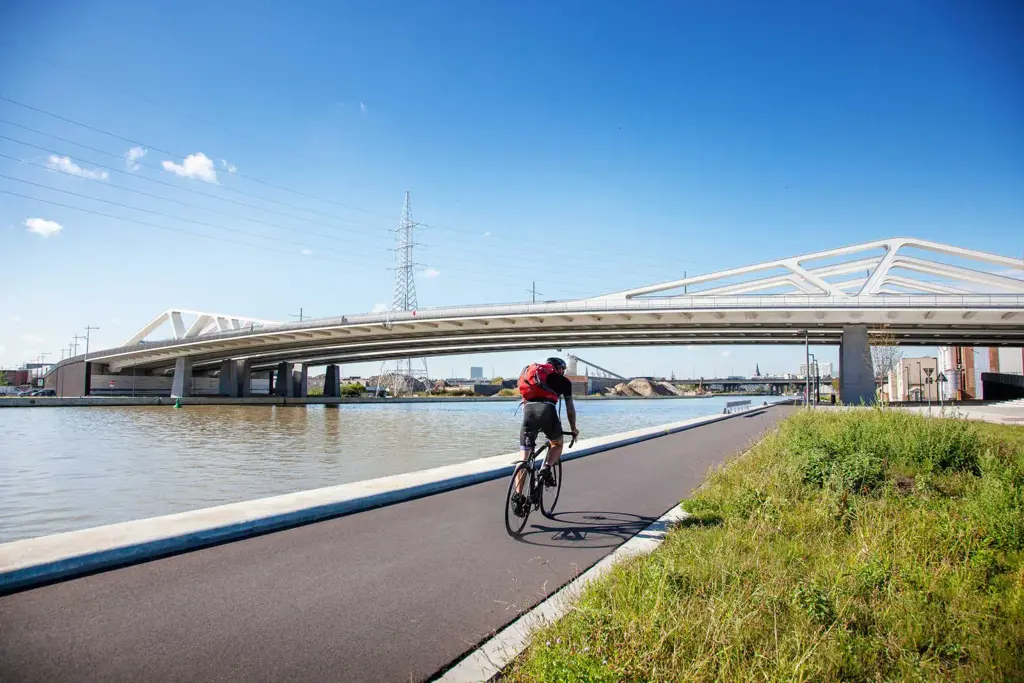Theunisbrug, Merksem - Deurne
Description
Een nieuwe Theunisbrug in Merksem - Deurne
Als je als een roofvogel boven Antwerpen kon hangen dan zou je de glinsterende Schelde zien die sloom slingerend vanuit het achterland langs de oude stad stroomt en uitmondt in een wereldhaven aan de Noordzee. Terwijl uit alle richtingen wegen samenkomen in een kluwen die De Ring heet en al decennia een groot verkeersprobleem vormt voor lokaal en doorgaand verkeer. De stad staat aan de vooravond van een groots project dat het leven met de Ring aanzienlijk hoopt te verbeteren, deels door overkapping en door de aanleg van geluidsschermen en groen. En dwars door die stad, van Schelde naar het Oosten doorklieft het Albertkanaal de noordkant van de stad om de Limburgse steden en Luik met de Antwerpse haven te verbinden. De hedendaagse binnenvaart vraagt om grotere sluizen en bredere vaargeulen en ook bij Merksem in het noordoosten van de stad wordt een bocht in het kanaal twee keer zo breed en de doorvaarthoogte vergroot. Dat vereist een geheel nieuwe Theunisbrug. In opdracht van De Vlaamse Waterweg ontwierp architectenbureau ZJA, in samenwerking met Arcadis, Sweco en OKRA Landschapsarchitecten, de verbinding van Duivelsplein naar Schijnpoortweg, over het Albertkanaal.
Een brug als boulevard
Het uitgangspunt van het ontwerp voor de Theunisbrug is een ruime verbinding voor tram, voetgangers, fietsers en auto’s die het gevoel van een boulevard geeft. Met zijn donkere pijlers en stralend witte en opengewerkte torens is de Theunisbrug een opvallende visuele ervaring in een hard en industrieel ogende omgeving. De nadruk ligt op de vloeiende beweging van alle soorten verkeer, en het verbeteren van de kwaliteit van de ervaring van het oversteken van het kanaal. De brug buigt en steekt in een flauwe bocht over, de fiets- en voetpaden aan de flanken van de brug bieden een vergezicht over het water en de stad. De torens zijn open vormgegeven en belemmeren die ervaring nauwelijks. In feite bestaat de Theunisbrug uit drie bruggen waartussen daglicht speelt, wat het overstekende verkeer een relatie tot het water geeft, maar ook licht brengt in de passages onder de brug aan de oevers. Een boulevard is niet alleen een weg, maar ook een passage langs interessante en prettige plekken, en met dat oogmerk is de Theunisbrug door ZJA ontworpen.
Verbinding met de omgeving
Om zo min mogelijk ruimtelijke aanpassingen te veroorzaken is de nieuwe, bredere Theunisbrug opgetrokken met rechte wanden met metselwerk in afwisselende patronen. Onder de brug en aan de kade wordt door decoratieve tegelpatronen, houten banken, groen en aangepaste verlichting een omgeving ingericht waar het prettig is om te verblijven en mensen zich veilig voelen. De passage van de Carrettestraat onder de brug aan de noordzijde is ook comfortabeler gemaakt met een wijkende wand voor meer overzicht en extra aandacht voor de toetreding van daglicht. Patronen in de tegelwand verwijzen naar de rimpelingen in het water. Het nabijgelegen Sportpaleis zal veel parkeerdruk geven en een op groene ondergrond aangelegde parkeergelegenheid tussen de aangeplante bomen moet ook voor die bezoekers de omgeving van de Theunisbrug verbeteren. De ruim aangelegde fietslus en de vier royale trappen met fietsgoot verbeteren de aansluiting op de omgeving en maken het oversteken van het kanaal niet alleen efficiënter, maar ook aantrekkelijker, als zintuiglijke ervaring.
Verhogen bruggen Albertkanaal
Met bijna 40 miljoen ton vervoerde goederen per jaar is het Albertkanaal de belangrijkste waterweg in Vlaanderen. Vooral het containervervoer kende het voorbije decennium een sterke groei. De huidige beperking in doorvaarthoogte en breedte onder de bruggen vormt een knelpunt voor de binnenscheepvaart op het Albertkanaal. De verhoging van de bruggen tot een vrije doorvaarthoogte van 9,10 m maakt het mogelijk om binnenschepen met vier lagen containers veilig en vlot te laten varen. Bovendien krijgt ook Short Sea Shipping op het Albertkanaal zo betere kansen.
Voor de realisatie van de werken wordt een deel van de kosten gefinancierd door de Europese Unie.
Architect: ZJA
Klant: De Vlaamse Waterweg
Opdrachtgever: Arcadis & Sweco
Aannemer: THV Artes-Stadsbader-Taveirne
Landschapsarchitect: OKRA Landschapsarchitecten
Jaar: 2015 - Lopend
[English]
A new bridge in Merksem
Hovering like a bird of prey high above the city of Antwerp you would see the glistening Schelde River, slowly meandering from the hinterland towards the old city and flowing out into a global seaport on the North Sea. From all directions highways and roads flock together to form a huge knot called The Ring, which has been causing problems for local and ongoing traffic for decades. The city is looking forward to the start of an immense project that aims to vastly improve life with the Ring, partly by roofing over the road and adding sound barriers and parks. Cutting right though the north of the city, from Schelde to the east is the Albert Canal, connecting the cities of Limburg and Liege with the port of Antwerp. Contemporary inland shipping demands bigger locks and wider canals, as is the case at Merksem in the north-east of Antwerp, where a bend in the canal will be made twice as wide while increasing the vertical clearance. This requires a completely new Theunis Bridge. Commissioned by De Vlaamse Waterweg and in collaboration with Arcadis, Sweco and OKRA Landscape architects, the architectural studio ZJA designed the connection from Duivelsplein to Schijnpoortweg, crossing the Albert Canal.
A bridge as boulevard
Starting point for the design of the new Theunis bridge is to provide a spacious connection for trams, pedestrians and cars that offers the feeling of a boulevard. With its dark pylons and bright white towers with open structures the Theunis bridge is a stark visual experience in an environment that appears hard and industrial. All emphasis in the design is on the flowing movement of traffic and the improvement of the quality of the experience of crossing the canal. The bridge bends and crosses the water with a gentle curve, with the bicycle paths at the outer lanes of the bridge offering quite a view of the water and the city. The pylons are as open as possible, hardly hindering that view. Actually the Theunis bridge consists of three separate bridges that allow daylight to play in the space between them, giving the traffic crossing the bridge a link to the water; at the banks on both sides of the canal light can also enter the passageway under the bridge. A boulevard is not just a road but also a passage along interesting and pleasant places, and the design by ZJA of the Theunisbridge was made with that in mind.
Connecting to the environment
In order to minimize the adaptations in the existing urban space the new and wider Theunis bridge is built with straight walls of masonry in varying patterns. Pleasant areas to sojourn are created by adding wooden benches, trees, lawns and decorative tile patterns on the walls. A custom made lighting plan and an open view help to feel at ease and safe. The passage way that leads the Carettenstraat under the bridge on the north side is made more comfortable by a receding wall on one side creating overview and allowing more light to enter. Images referring to the ripples in the water in the tiles of the wall connect the bridge to the neighborhood. The nearby Sportpaleis creates the need for a lot of parking space and a so a parking facility created on a green surface among newly planted trees will also further improve the environment around the Theunis bridge. To make sure that crossing the bridge by bicycle becomes more efficient there is a spacious elevated bicycle path connecting the two levels and four wide staircases with a gutter to lead the bike. Using the bridges as a cyclist or as a pedestrian will become more practical but also a more interesting sensory experience.
Increasing clearance height of Albertkanaal bridges
With nearly 40 million tons of goods transported annually, the Albert Canal is the most important waterway in Flanders. Container transport in particular has experienced strong growth in the past decade. The current limitation in clearance height and width below the bridges is a bottleneck for inland navigation on the Albert Canal. Increasing the clearance height of the bridges to 9.10 m makes it possible to let inland vessels with four layers of containers sail safely and smoothly. Moreover, Short Sea Shipping will also be given better opportunities on the Albert Canal.
Part of the costs for the project are financed by the European Union.
Architect: ZJA
Principal: De Vlaamse Waterweg
Client: Arcadis & Sweco
Contractor: THV Artes-Stadsbader-Taveirne
Landscape architect: OKRA Landscape architects
Year: 2015 - Present
Expertise: Architecture

Werk ook slimmer met Galleo
Galleo brengt projectdata, kennis en AI samen in één veilige, schaalbare oplossing. Toonaangevende bedrijven zoals ABT, Movares, CLAFIS en Witteveen+Bos kiezen al voor Galleo. Sluit je aan.
Neem contact op met Barbara of Kars
We werken zelf in de gebouwde omgeving en adviseren je graag, met praktijkervaring en vakkennis, over wat het beste werkt voor jouw organisatie.
Neem contact op